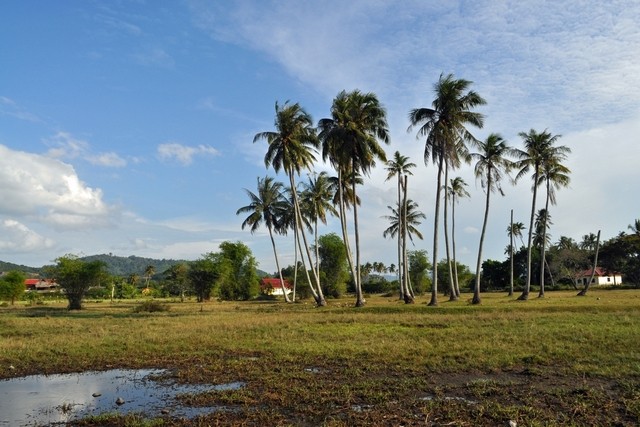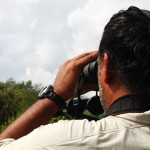From the beach to Beach Street, creature comforts in Malaysia and Thailand
From Beach to Beach Street by Rosemary Behan on March 17, 2014
 “Symbiosis, commensalism, mutualism, parasitism. It’s all been going on here in this rainforest for at least 10 million years.” It’s eight o’clock in the morning and Irshad Mobarak is just getting into his stride. The passionate naturalist for The Datai Langkawi hotel, and owner of JungleWalla Tours, is bombastic and strikingly convincing on topics as diverse as the natural world around him.
“Symbiosis, commensalism, mutualism, parasitism. It’s all been going on here in this rainforest for at least 10 million years.” It’s eight o’clock in the morning and Irshad Mobarak is just getting into his stride. The passionate naturalist for The Datai Langkawi hotel, and owner of JungleWalla Tours, is bombastic and strikingly convincing on topics as diverse as the natural world around him.
I’m here on one of his morning group nature walks into the rainforest surrounding the Datai, on Langkawi’s north-west coast. Mobarak has already informed us that before a meteor struck all those years ago, Langkawi was part of a 550-million-year-old rock formation, “the oldest in South East Asia … 240 million years ago it became an island. Ten million years ago it was struck by a meteor with the force of between 10 and 15 Hiroshimas, which was what we call an extinction event. Only the hardiest creatures and seed survived”.
Apart from the hotel, which has recently redeveloped a nearby golf course, this section of the island – a few hundred hectares – is protected and, thankfully, still largely undeveloped. While it’s not Borneo, either side of the narrow, winding road to the resort is thick jungle (Mobarak prefers to call it an “ecological hotspot”), where the towering strangler figs and buttress trees are filled with monkeys, hornbills, eastern broadbill rollers, Pacific swallows, Asian fairy bluebirds, mountain hawk eagles, termite mounds and plants with the properties of steroids (tongkat ali for male virility, kacip fatimah for women. “Don’t get them mixed up,” says Mobarak).
We see two of the most interesting species in the hotel garden. First, a colugo, or rare flying lemur, is sleeping while vertically attached to a tree, just out of reach. Below it are short, tough-looking palm trees called cycads that apparently cause brain cancer if ingested.
In truth, I’m relieved to have chosen this hotel. Dubbed the “Muslim Hawaii” for its laid-back island lifestyle, large parts of Langkawi are disappointingly bland; the main resort town, Pantai Cenang, is an overdeveloped tangle of beach bars, overpriced hotels and uninspiring restaurants.
Opened in 1993, the Datai has maintained a loyal following despite increasing competition on the island. Its most recent developments are the new beach villas, 14 separate, 218-square-metre, Kerry Hill-designed structures, just metres from the resort’s private beach, each with walled-in outside areas including a private swimming pool and separate wood-and-glass living areas, which cost from Dh8,000 per night in low season.
I’d arrived the previous afternoon, thrown open the windows, turned off the air con and collapsed into a deeper sleep than I’d had in a long time. Surrounded by jungle right down to the sea, I can hear both the sound of the waves and the hypnotic, synchronised screech of cicadas. The sea air, filtered through the rainforest, is so clean you feel that every breath is doing you good.
I admire the view of the Thai island of Tarutao in the distance before swimming in the sea, having a late lunch at the Beach Club and kayaking round a nearby island. The sea is rich with plankton and run-off from the rainforest, meaning Malaysia’s beaches don’t dazzle like Thailand’s, but the water is clear and serene, and the view across the bay to the jungle-covered mountain is the stuff of travel fantasies.
The food is uniformly excellent. The buffet breakfast at The Dining Room, overlooking the swimming pool and forest, features several live cooking stations that change daily. For lunch I have delicate ginger-steamed snapper and green vegetables at the Beach Club; at the open-air Malay-Indian Gulai House, situated in the jungle, it’s a feast of crab lemongrass soup, black pepper beef, stir-fried squid and biryani rice, followed by a sensational cendol pulut dessert – coconut milk, palm sugar, sticky rice and red kidney beans. At a Thai restaurant, The Pavilion, situated on stilts in the forest canopy, I try papaya salad, tom yam soup, whole deep-fried fish with mango and seasonal vegetables in oyster sauce, followed by a dessert of water chestnut dumplings with jackfruit.
After just 24 hours of rest, good food, exercise and an hour-long kuat massage in an open-air room at the spa, I feel alive in that top-to-toe way that would take weeks to achieve in noisier, more stressful locations.
The waterfalls at Telaga Tujuh, half an hour down the road, seem unpleasantly crowded and disconcertingly littered in comparison. The most worthwhile excursion outside the resort we make is a Geopark Mangrove Cruise with Mobarak, around Langkawi’s north coast; yet here again, boat operators are feeding kites and sea eagles to please the increasing crowds of visitors, some boats are belching smoke and, after stopping for a lunch of fish and chips on the scenic northern public beach, we are happy to hightail it back to the Datai.
After three nights, it’s time to move on and I check into Temple Tree at Bon Ton, about half an hour’s drive away on the island’s south-west coast. This is a new part of the Bon Ton resort and restaurant, a beautifully styled collection of houses next to a lagoon. My room is actually a whole house, “rescued” from a rural village near Kuala Lumpur. Named “Black & White” after its colour, it’s a traditional 1940s Malay wooden home on stilts, the likes of which are increasingly rare in Langkawi as local families with money “upgrade” to concrete homes. It’s refreshingly cool, thanks to the traditional ventilation system. The bathroom has a wooden floor and a shower that drains through the floorboards; there is a wooden bathtub in the bedroom and a covered porch filled with cats, though – thanks to a nearby road, the proximity of the airport and the barking of dogs – it isn’t as peaceful outside as it looks. The view over the lagoon, particularly from the gorgeous Nam restaurant, is striking, and the prawn pineapple curry, laksa and a salad of green leaves, rocket, sesame cashews, avocado and Parmesan, are more plentiful and better value than the meals at the Datai. Between my room and the colonial-style Straits Club House and Restaurant, this would be the perfect place, if you could afford it, to stay and write a book.
In between book-reading from the library, Mobarak takes us on a tour of the central part of the island, including a drive to the top of its highest mountain, Gunung Raya, which offers a great view of the southern islands but is marred by a hideous concrete hotel. Along the way we meet a person Mobarak calls “cobra man”, who apparently holds a world record for spending 28 days locked in a room full of cobras. Mobarak tells me about his family history, which includes Welsh, Portuguese and Punjabi lineage. Stopping at a service station for petrol, he spots 20 great hornbills feeding on a strangler fig, which starts him on a treatise on Langkawi’s bird life.
“The great hornbill is such a charismatic bird … There are 236 types of migratory birds on the island thanks to its diversity … And 502 species of butterfly – that’s 437 more than the UK.”
On the way home Mobarak takes us to a night market (pasar malam) at Padang Lalang, which proves gloriously local and tourist-free.
Early the next morning, we head to Telaga Harbour, on the island’s west coast, to catch a one-hour speedboat to Koh Lipe, one of Thailand’s most picturesque islands. Arriving on Koh Lipe’s southerly Pattaya Beach, we are then taken by long-tail boat to Castaway Beach Resort on the island’s more exposed east coast. It’s windy on this side, but the weather doesn’t dull the brilliant colour of the sea, which I jump into as soon as we arrive. We meet a Kuala Lumpur-based hotel designer, Randi, and a family living in Dubai, including Richard, who works for Nokia, and Robin, a nutritionist, who recommends a great agriturismo in Pienza. With Thai massages for less than Dh50 an hour and Fernando from Ibiza conducting yoga classes on the deck, it’s like an adult youth hostel, but easily the most stylish place to stay, with two-storey wooden bungalows with bedrooms upstairs and a large, raised outdoor restaurant and lounge.
The rest of the small island, while attractive, is crowded with tourists in December and looks to be in danger of being loved to death (what’s not to love about cafes with 96 different types of fruit shakes or Dh6 snacks from the Thai Lady Pancake Shop?). There is already a large, unattractive hotel at one end of Pattaya Beach and another under construction, catering mainly to increasingly affluent travellers from elsewhere in South East Asia, who travel to Langkawi and Phuket on low-cost flights from Kuala Lumpur, Singapore, Tokyo and elsewhere.
 Previous Post
Previous Post Next Post
Next Post







